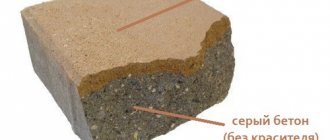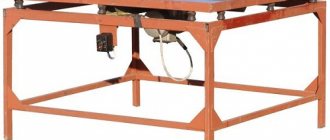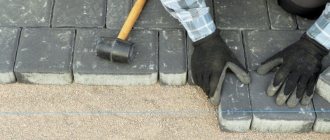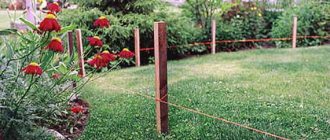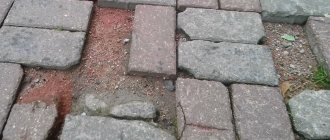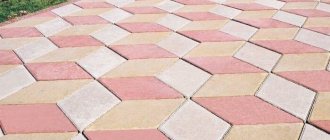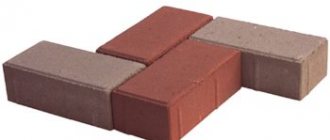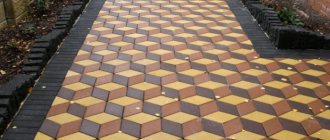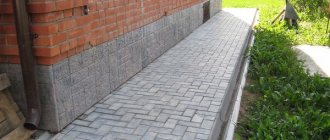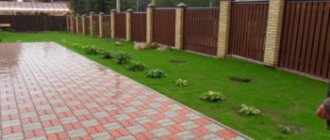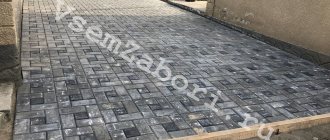How to start a business in the production of concrete paving slabs.
For the production of tiles using the vibration casting method, a room of 100 m² with a three-phase power supply is suitable; the equipment you will need is:
- Forming vibrating table.
- Formwork table.
- Set of plastic forms.
- Forced type concrete mixer.
- Heated water container.
- Container for washing solution.
Portland cement M500 is used to prepare concrete (the content of SZA in clinker should not exceed 8%). Cement must be used from the same manufacturer; different types of cement, when painted with dye, give different shades of the finished tile. Also used are sand with a particle size modulus of 2, crushed stone of a fraction of 5 - 10 mm, a grade of crushed stone in terms of compressive strength of 1000, frost resistance of at least 200, a plasticizer additive, an air-entraining additive, pigment, water.
Consumption of materials for preparing concrete mixture per 1 m². tiles (tile thickness 6 cm):
- cement – 36 kg,
- sand - 45 kg,
- granite crushed stone fr. 5 – 10 mm – 45 kg,
- plasticizer – 0.7% by weight of cement,
- pigment – 2.5 by weight of cement,
- air-entraining additive - up to 0.02% by weight of cement.
Technology for the production of vibropressed paving slabs, molding.
" Back 25.11.2014 22:40Paving slabs are a technologically advanced material that allows you to lay paths and areas of any size and configuration. Laying tiles on a sandy base gives the coating many advantages compared to a solid asphalt concrete surface:
- no puddles form on the surface of such a coating, since water flows freely through the gaps between the tiles;
- the tiled covering does not violate the natural need of green spaces for water and gas exchange, which has a beneficial effect on the ecology of the surrounding space;
- if it is necessary to carry out repair work (for example, laying underground communications), paving slabs can be easily removed, the necessary work can be carried out and laid again;
- in summer, the heating of a tile coating is much less than that of dark asphalt; At the same time, the tile coating does not soften and does not emit volatile products.
In addition to the actual tiles made from decorative cement concrete, a variety of garden design elements can be produced.
Two technologies for the production of paving slabs :
- vibrocompression of rigid mixtures with low water content (low W/C);
- vibration casting using plasticizing additives.
Both methods make it possible to obtain concrete tiles with low porosity due to the low water content in the concrete mixture and ensuring dense placement of the concrete mixture using mechanical influences (vibration or vibropressing). Each of these methods does not have any fundamental advantage, so they exist in a competitive mode. However, ensuring guaranteed quality of paving slabs is easier to achieve when using the vibratory casting method using mixtures with plasticizing additives.
Today, the technology for producing paving slabs using vibration casting in plastic molds is used in more than a hundred cities in Russia. The number of manufacturers is growing rapidly, since in order to start production you need very little: a room with an area of 100-300 m2, three-phase power supply, one or two concrete mixers, one or two forming tables, a stripping table and a set of plastic molds. All this will be enough to produce shaped paving stones, square slabs of various thicknesses, facade tiles imitating natural stone, decorative fences with a height of 50 to 200 cm or gutters.
Paving slabs manufactured in accordance with GOST 17608-91 “Concrete paving slabs” are subject to strict requirements for frost resistance (at least 200 freezing and thawing cycles), strength (at least 30 MPa), water absorption (no more than 5%) and abrasion resistance (not more than 0.7 g/cm?). Therefore, the creation of a material of the required quality begins with the selection of the necessary high-quality materials for its manufacture.
To prepare concrete, Portland cement M500 D0 (GOST 10178-85) is usually used; the clinker content of C3A should not exceed 8%. When choosing cement, it is advisable to choose one plant, because... When pigments are added to concrete, the dye does not color the aggregates (sand and crushed stone), but rather the cement binder. Changing the supplier and type of cement leads to a change in the final color of the concrete obtained after painting. The reason for this is the difference in the original color of the cement.
As a fine aggregate, construction sands with a fineness modulus of at least 2 should be used, meeting the requirements of GOST 8736-93. Crushed stone from igneous rocks (for example, granite) of a fraction of 5-10 mm, meeting the requirements of GOST 8267-82, should be used as a coarse aggregate. Preferred suppliers are quarries that guarantee the shipment of crushed stone of hydraulic classification (washing) and that does not contain fractions finer than 5 mm at the time of shipment. The grade of crushed stone in terms of compressive strength should be no lower than 1000, in terms of frost resistance no lower than 200, the recommended content of lamellar (flaky) and needle-shaped grains in crushed stone is no more than 25% by weight. Water for concrete mixtures must meet the requirements of GOST 23732-79.
To increase frost resistance, strength and improve the technological properties of concrete, a complex additive containing a plasticizing component (S-3 or LST) together with an air-entraining or water-repellent (SNV or GKZh-94) component should be introduced into the concrete mixture.
Approximate consumption of concrete mixture components per 100 sq.m. tiles 6 cm thick are: cement - 3.6 t, crushed granite fraction 5-10 mm - 4.5 t, sand - 4.5 t, plasticizer S-3 - up to 0.7% by weight of cement, air-entraining additive SNV - up to 0.02% by weight of cement, pigment - 2...5% by weight of cement.
In a number of regions where there are difficulties in delivering granite crushed stone, high-strength frost-resistant fine-grained concrete can be used without the use of granite screenings. To prepare such concrete, Portland cement M500DO, sand and a complex additive consisting of microsilica (SiO2 - amorphous modification) and superplasticizer C-3 are used. The main factor in the mechanism of action of microsilica is the reaction of interaction between silicon dioxide SiO2 and calcium hydroxide Ca(OH)2, formed during hardening of cement, with the formation of hydrosilicates (i.e., as if an additional amount of cement stone). The use of microsilica in an amount of 10% by weight of cement and superplasticizer S-3 in an amount of 1% by weight of cement makes it possible to obtain fine-grained concrete with a strength of up to 70 MPa and frost resistance of 300 cycles.
The production of colored decorative concrete is impossible without the use of pigments. The pigments must be resistant to the alkaline environment of the hardening cement binder; in addition, they must be light and weather resistant. Pigments should not dissolve in mixing water. Inorganic oxide pigments meet these requirements better than others. With the help of such pigments you can achieve almost any tone, and, first of all, the muted color range that is characteristic of nature. A pure color, such as yellow or blue, can only be achieved using white cement. The amount of pigments added to concrete is 2...5% - for pigments with good coloring ability, produced, for example, by Bayer (Germany) or Usov and Preheze (Czech Republic). Pigments with lower coloring power (mainly from domestic manufacturers) have to be introduced in quantities of up to 8%. The disadvantages of domestic pigments include the inconsistency of color among pigments of the same brand.
It should be noted that an excessive increase in the fine fraction in the form of pigments can lead to a deterioration in the quality of concrete (reduced strength, frost resistance, etc.). The color of concrete also depends on the ratio of water and cement, and the amount of cement in the concrete. As concrete hardens, excess water evaporates and leaves small pores in the concrete, which scatter light and “brighten” the concrete. The higher the W/C, the lighter the concrete appears. Therefore, when producing tiles using the vibration pressing method (with a very low W/C), it is impossible to obtain concrete of saturated colors.
To increase the durability of concrete, its wear resistance and impact resistance, polypropylene, polyamide or glass alkali-resistant fibers with a length of 5...20 mm and a diameter of 5...50 microns can also be added to concrete in an amount of 0.7...1.0 kg per 1m3 of concrete. Fibers with good dispersion form a three-dimensional lattice in concrete, which significantly increases adhesion forces.
| Fig.1 Concrete mixture preparation unit |
The technology for manufacturing paving slabs includes several main stages:
- preparation of forms;
- preparation of concrete mixture;
- forming on a vibrating table;
- keeping products in molds for 24 hours;
- stripping of products;
- packaging and storage.
PREPARATION OF FORMS
Molds for making paving slabs can be made of plastic, rubber and rubber-like (polyurethane). The number of molding cycles that the molds can withstand is: for rubber - up to 500 cycles, for plastic - 230-250, for polyurethane - 80-100 cycles.
Before pouring concrete into them, molds are lubricated with special compounds or concrete is poured without first lubricating the mold. When working without lubrication, new forms are treated with an antistatic agent; after stripping, the forms are inspected and, if necessary, washed with a 5-10% solution of hydrochloric acid.
To lubricate the molds, you can use emulsol, OPL-1 (Russia) and SYA-3 (England). To preserve the surface of the mold, do not use lubricants containing petroleum products. The layer of lubricant applied to the surface of the molds should be thin, since due to excess lubricant, pores remain on the surface of the finished product. Emulsol and OPL-1 lubricants are applied with a brush before each fill; SPA-3 lubricant is applied with a brush or spraying. SVA-3 lubricant is enough for 2-3 molds. The temperature during application should be 18-20°C.
PREPARATION OF CONCRETE MIXTURE
To prepare decorative concrete, it is better to use a forced-action concrete mixer. Basically, the procedure for preparing the mixture does not differ from the preparation of ordinary concrete (Fig. 1). The pigment is applied approximately 30 seconds before the cement is applied.
Optimal mixing mode: sand + pigment - 15-20 s; sand + pigment + crushed stone - 15-20 s; sand + pigment + crushed stone + cement - about 20 s; sand + pigment + crushed stone + cement + water + additives - 1-1.5 minutes; total - 2-2.5 minutes.
To increase the durability of concrete, its wear resistance and impact resistance, polypropylene, polyamide or glass alkali-resistant fibers with a length of 5-20 mm and a diameter of 5-50 microns can also be added to concrete in an amount of 0.7-1.0 kg per 1 m3 of concrete. The length of the fibers should correspond to the largest diameter of the coarse aggregate in the concrete. Fibers with good dispersion form a three-dimensional lattice in concrete, which significantly increases the flexural strength, impact resistance and wear resistance of concrete.
Polypropylene and alkali-resistant glass fibers are introduced with mixing water; polyamide fiber is introduced into the finished concrete mixture, i.e. at the last stage, while the mixing time of the mixture is increased by 30 -50 s.
When using a microsilica additive, take the following schedule for preparing the concrete mixture: sand + microsilica + pigment - 30-40 s; sand + microsilica + pigment + cement - about 30 s; sand + microsilica + pigment + cement + water + additives - 1-1.5 min.
MOLDING ON A VIBRATING TABLE
The finished concrete mixture has a workability of OK = 3-4 cm. Therefore, short-term vibration treatment is used to compact it. After preparing the concrete mixture, it is placed in molds and compacted on a vibrating table (Fig. 2).
| Fig.1 Vibrating table |
When producing colored tiles in plastic molds, layer-by-layer molding can be used to save pigment: the first face layer of concrete is prepared using pigment, the second layer of concrete is prepared without it. For separate molding, it is necessary to have two mixers for preparing the first and second layer of concrete.
When forming, a 2 cm thick face layer of colored concrete is first laid and compacted for 40 s. After this, a 2nd layer of concrete without pigment is laid and compacted by vibration for another 20 s. If the mobility of concrete is different, it is necessary to select your own compaction time on the forming table.
CUTTING OF PRODUCTS
After molding, the products in the molds are installed in stacks 3-8 rows high, depending on the thickness and configuration of the tiles. For example, square slabs are placed in no more than 3 rows. After this, the stacks are covered with plastic film to prevent moisture evaporation. The holding temperature must be at least 15 °C. No additional heating is required. After 24 hours of holding in the molds, you can remove the formwork (release the products from the molds).
STRIPPING
Stripping of shaped products is carried out on a special knockout table with vibration (Fig. 3), and to facilitate stripping of the form with products, it is recommended to heat it for 2-3 minutes in a bath of hot water (temperature 45-50 ° C). This takes advantage of the high thermal expansion of polymers compared to concrete. The demoulding of square slabs and façade tiles occurs without any special equipment. It should be noted that stripping without preheating shortens the life of the mold by approximately 30% and can lead to defective finished products, especially for thin products.
PACKAGING AND STORAGE
After stripping, the tiles are laid on Euro pallets “face” to “back”, tying them with packing tape. To ensure further hardening of the concrete and preserve the presentation of the products, they must be covered with polyethylene shrink or stretch film. In the summer, products are released when they reach 70% of the design strength, which approximately corresponds to 7 days of concrete hardening, counting from the moment of its manufacture. In winter, tempering is carried out when 100% of the design strength is reached (28 days from the moment the concrete is prepared).
In conclusion, we present the nomenclature and calculation of the cost of the equipment necessary to organize a workshop for the production of paving slabs
Equipment and materials for the production of paving slabs GOST 17608-91 using the vibration casting method *
| № | Name | Unit. | Quantity | power, kWt | Price per one. c.u. | Total $ | Manufacturer country |
| Equipment for the production of | |||||||
| 1. | High-power vibrating table with vibrating block | PC. | 2 | 2,2×2=4,4 | 600 | 1200 | Russia |
| 2. | Vibrating formwork table without vibrator | PC. | 1 | 2,2×2=4,4 | 600 | 600 | Russia |
| 3. | Vibrating table SB-80 forced action without skip | PC. | 2 | 4,5×2=9 | 2000 | 4000 | Russia |
| 4. | Vibrator | PC. | 1 | 1 | 200 | 400 | Russia |
| Total | 14,4 | 6000 | |||||
| Plastic molds 60 mm | |||||||
| 1. | Clover relief | PC. | 2800 | 0,85 | 2380 | Poland | |
| 2. | Honeycomb | PC. | 3750 | 0,85 | 3188 | Poland | |
| Total | 5568 | ||||||
| Materials for concrete production (for 1 month of work) | |||||||
| 1. | Red pigment “Usovsko” type 6 1/847 | kg | 1050 | 1,5 | 1575 | Poland | |
| 2. | Superplasticizer S-3 | kg | 370 | 0,85 | 314 | Poland | |
| Total | 1889 | ||||||
Line capacity 100 m2 per shift Installed power of electrical equipment 15 kW Number of service personnel 12-13 people. Required area 500 m2
Provided by TROTUAR.RU and the Construction magazine - Information Bulletin.
RELATED MATERIALS
|
Technology for manufacturing paving slabs using vibration casting.
The production process of paving slabs can be divided into stages:
- Lubricating plastic molds.
- Preparation of concrete.
- Filling plastic forms with concrete.
- Vibrocasting.
- Excerpt of completed forms.
- Form removal.
- Preparing molds for new pouring (washing, lubrication).
1.Preparation of forms.
Before starting pouring, forms for subsequent high-quality stripping should be lubricated with a special lubricant. You can purchase such a lubricant or make it yourself.
Plastic mold release agent can be prepared by mixing 30% machine oil and 70% diesel fuel.
2. Preparation of concrete.
When preparing concrete, it is preferable to use a forced-action concrete mixer for better mixing of the solution.
Composition of the solution per concrete mixer:
- Granotsev – 50l.
- Cement M 400 – 25 l.
- Sand – 25l.
- Water – 25 l.
- Plasticizer C3 – 100g.
- Pigment dye.
3.Filling.
The forms are placed on a vibrating table and filled evenly with the solution; the forms are kept on the vibrating table for 15 - 20 seconds. Excess concrete is removed with a spatula.
4.Drying and storage.
After the concrete filling process, the forms are laid on a flat area for 48 hours to dry. It is important that the surface of the drying area is level; if the forms are on a slope, the concrete will move and the tiles will not have the same thickness. It is almost impossible to lay such tiles evenly.
5. Stripping.
After drying, it is necessary to remove the finished tile from the mold. To successfully remove tiles and increase the service life of plastic molds, place them in a container with hot water (60 - 70°C) for 5 minutes.
Then the tiles are knocked out on the formwork table using special devices.
After removing the tiles, the forms are cleaned of concrete residues, washed in a 7-10% solution of hydrochloric acid, and finally rinsed with plain water. After drying, the forms are lubricated back with lubricant for new concrete pouring.
Environmental indicators
Regardless of the production technology, vibro-cast or vibro-pressed concrete paving stones are absolutely environmentally friendly.
This indicator for piece products is at the highest level, making them absolutely pure in this regard. No harmful chemicals or pollutants are used in their production. This gives concrete tiles a great advantage over asphalt, polymer and rubber materials, which, when heated by sunlight, emit substances harmful to health.
Technology for manufacturing paving slabs using vibration pressing.
This technology is based on the method of vibration compaction of semi-dry concrete mixture with low cement and water content.
This method makes it possible to produce paving slabs with high performance properties with water absorption of less than 5%, and increased frost resistance F-200 - F-300. Tiles made using a vibropress have a much longer lifespan compared to the vibratory casting method.
When producing paving slabs using the vibration pressing method, you will need the following equipment:
- Hydraulic vibropress.
- Technological pallets.
- Forced type concrete mixer.
Today, it is increasingly rare to see asphalt pavement on city sidewalks and squares, where neatly laid, tastefully selected paving slabs are pleasing to the eye. The curb stone has a clear, as if drawn, contour and a dense structure that is noticeable even to the eye.
Today, in order to obtain high-quality paving, you do not need a reinforced concrete plant with numerous personnel and a long production cycle, and there is no need to use bulky asphalt paving equipment. All this can be replaced by the simple technology of semi-dry vibrocompression. This method of manufacturing a variety of paving slabs, curb stones of various configurations, palisade posts and other landscaping elements is attracting increasing attention from manufacturers of such products.
The technological process of semi-dry vibration compaction involves the molding of a concrete product (paving slabs, wall blocks, etc.) in a special mold while simultaneously being exposed to vibration and pressure created by special pressing equipment. Concrete with a low water-cement ratio is used to manufacture products using the semi-dry vibrocompression method. The process lasts a few seconds: exactly as long as is required for high-quality processing of concrete in the form. As a result, an almost finished product comes out of the mold, which can only be dried in a steaming chamber for three hours at a temperature of 60ºC. Due to the low water content in concrete, during the drying process under the specified mode, no internal stress arises in the product, which means that the possibility of crack formation is eliminated.
The advantages of vibrocompression technology are obvious:
- The concrete compositions used ensure high strength and frost resistance of products, and, consequently, their durability. In addition, due to the unique rough surface, paving slabs provide significantly greater safety for traffic on the streets, which is especially important in the cold season. All this allows us to conclude about the high performance qualities of the finished products;
- Due to the use of specialized molds, products produced by vibration pressing have clear contours, verified parallel surfaces, and an attractive appearance;
- this method is highly productive and economical, which is due not only to the high speed of molding products, but also to the relatively low cement content in the compositions of the concrete mixtures used;
- ease of reconfiguring the line and a large set of interchangeable molds included in the production line set allows you to quickly switch to the production of other varieties and modifications of products;
- Due to the high degree of automation of the technological process, the influence of the human factor is reduced to a minimum, which allows us to guarantee consistently high quality products.
A modern semi-dry vibrocompression line (vibropress) has a wide range of capabilities, such as:
- ensuring the production of a wide range of high quality products and precise geometry;
- the possibility of using local materials as fillers for concrete mixtures: sand, slag, ash, small fractions of expanded clay, crushed stone screenings and even sawdust, which, due to the peculiarities of the technology, does not in any way impair the strength characteristics of the products;
- speed of installation and commissioning;
- saving materials due to dosing accuracy;
- high productivity of the line, the possibility of both autonomous operation on a construction site and as part of a technological module of the same type of equipment.
Sales and Marketing
There are several groups of clients that are key to this area
- Budgetary enterprises, state and municipal facilities.
Such orders account for approximately 50-80% of all requests. Typically, materials are purchased for the improvement of public areas, but this is not the only area. The territory of schools, kindergartens, and medical institutions is also not complete without landscaping. The conclusion of state and municipal supply contracts is the main channel through which sales occur. To do this, the company needs to participate in auctions and tenders in the production of paving slabs; the price of the equipment does not affect this opportunity.
- Commercial sector.
We are talking about retail establishments, catering establishments, and so on. Electronic commercial auctions and direct interaction with clients are the main ways to achieve results.
- Private clients.
Usually this refers to individuals who are also interested in issues related to landscaping. The tiles can be sold in construction hypermarket chains. You can use the services of markets and sales through the official website. The production of paving slabs as a business is difficult to organize at first, but later it will be easier.
Market overview and competition assessment
The market for construction and finishing materials is one of the few areas of production in Russia that is almost unaffected by economic crises. This is an important property due to which both large and small enterprises are attracted to this direction. A business will be successful and profitable only if the following factors are taken into account:
1. Volume and growth dynamics of the paving slab market in Russia.
Up to 12-14 million square meters of this building material enter the market every year. The minimum growth rate each year is 5-9%. The indicators are due to the fact that in different cities and regions from time to time there is a strong demand for the replacement of outdated asphalt pavements. That is, the guarantee of return on investment is almost 100%. The average profit rate in the end is no less than 20-30%. The production of blocks and paving slabs is always in demand.
2. Costs are reduced thanks to modern equipment and technologies.
Most of the technological process is now automated. This makes it easier to take an individual approach to requests from each client. To fulfill orders, it is easy to use modeling and construction of 3D objects. There is virtually no competitive influence from imported products. All technological components are purchased without problems using only the local market. Finding a machine for the production of paving slabs is also not difficult.
